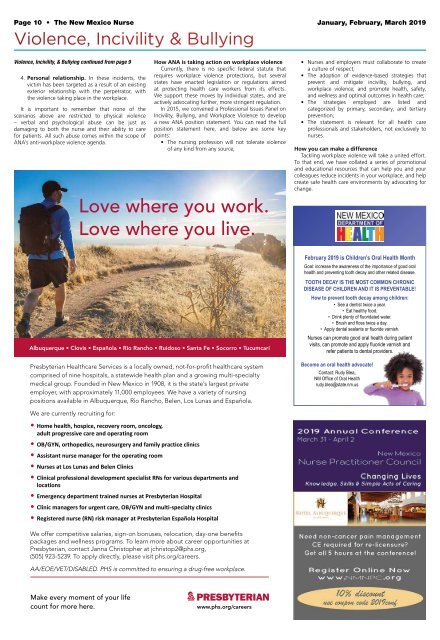The New Mexico Nurse - January 2019
Create successful ePaper yourself
Turn your PDF publications into a flip-book with our unique Google optimized e-Paper software.
Page 10 • <strong>The</strong> <strong>New</strong> <strong>Mexico</strong> <strong>Nurse</strong> <strong>January</strong>, February, March <strong>2019</strong><br />
Violence, Incivility & Bullying<br />
Violence, Incivility, & Bullying continued from page 9<br />
4. Personal relationship. In these incidents, the<br />
victim has been targeted as a result of an existing<br />
exterior relationship with the perpetrator, with<br />
the violence taking place in the workplace.<br />
It is important to remember that none of the<br />
scenarios above are restricted to physical violence<br />
– verbal and psychological abuse can be just as<br />
damaging to both the nurse and their ability to care<br />
for patients. All such abuse comes within the scope of<br />
ANA’s anti-workplace violence agenda.<br />
How ANA is taking action on workplace violence<br />
Currently, there is no specific federal statute that<br />
requires workplace violence protections, but several<br />
states have enacted legislation or regulations aimed<br />
at protecting health care workers from its effects.<br />
We support these moves by individual states, and are<br />
actively advocating further, more stringent regulation.<br />
In 2015, we convened a Professional Issues Panel on<br />
Incivility, Bullying, and Workplace Violence to develop<br />
a new ANA position statement. You can read the full<br />
position statement here, and below are some key<br />
points:<br />
• <strong>The</strong> nursing profession will not tolerate violence<br />
of any kind from any source;<br />
• <strong>Nurse</strong>s and employers must collaborate to create<br />
a culture of respect;<br />
• <strong>The</strong> adoption of evidence-based strategies that<br />
prevent and mitigate incivility, bullying, and<br />
workplace violence; and promote health, safety,<br />
and wellness and optimal outcomes in health care;<br />
• <strong>The</strong> strategies employed are listed and<br />
categorized by primary, secondary, and tertiary<br />
prevention;<br />
• <strong>The</strong> statement is relevant for all health care<br />
professionals and stakeholders, not exclusively to<br />
nurses.<br />
How you can make a difference<br />
Tackling workplace violence will take a united effort.<br />
To that end, we have collated a series of promotional<br />
and educational resources that can help you and your<br />
colleagues reduce incidents in your workplace, and help<br />
create safe health care environments by advocating for<br />
change.<br />
February <strong>2019</strong> is Children’s Oral Health Month<br />
Goal: increase the awareness of the importance of good oral<br />
health and preventing tooth decay and other related disease.<br />
TOOTH DECAY IS THE MOST COMMON CHRONIC<br />
DISEASE OF CHILDREN AND IT IS PREVENTABLE!<br />
How to prevent tooth decay among children:<br />
• See a dentist twice a year.<br />
• Eat healthy food.<br />
• Drink plenty of fluoridated water.<br />
• Brush and floss twice a day.<br />
• Apply dental sealants or fluoride varnish.<br />
<strong>Nurse</strong>s can promote good oral health during patient<br />
visits, can promote and apply fluoride varnish and<br />
refer patients to dental providers.<br />
Become an oral health advocate!<br />
Contact: Rudy Blea,<br />
NM Office of Oral Health<br />
rudy.blea@state.nm.us

















